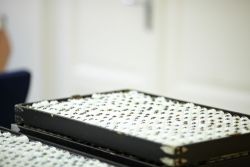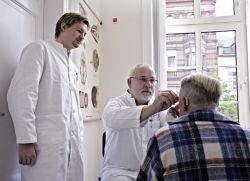Artificial eyes

Since 1860, F.Ad. Müller Söhne has manufactured and fitted artificial eyes. The following page gives background information on artificial eyes. Up until some years ago it was fair to say that roughly one out of every 1000 European citizens had an artificial eye. This figure is slowly decreasing since better diagnosis and improved surgical methods can save more eyes. The art of making artificial eyes is however far from new. Already in the 14th century, Venetian glassblowers mastered the skill.

Material and Production
A semi-manufactured prostheses
F.Ad. Müller Söhne uses special cryolith glass to manufacture eye prostheses. The glass is non-organic organic and is partially made of cryolith and partially of crystal. These types of glass are well proven and tested and the best suited materials regarding cosmetic appearance, usability and compatibility. They also do not release any harmful substances.
An eye prosthesis is fitted between the upper and lower eyelids. It is not a surgical operation to fit the prosthesis and it is not fastened in any way. The remaining muscles in the eye socket can make the prosthesis move together with the healthy eye. This does however depend on the surgical construction of the eye socket. Artificial glass eyes are manufactured either as hollow balls or very thin shells. The proper shape of the artificial eye must be determined by an ocularist, depending on the conditions of the eye socket. The weight varies between 1,3 and 4,5 metric grams.
The glass material we use is made in Thuringia, Germany. The area has a long tradition of glass making. It is from here that we get the glass tube that is our base for the eye bulb, as well as material for the pupil and the iris. The material for the iris is mixed from different combinations of coloured glass by the ocularist.

Fitting the prostheses to the patient
The artificial eye is fitted during a consultation to our ocularists in one of the hospitals or towns we visit. By examining the colour of the patients remaining eye, the ocularist can pick a suitable colour from a large set of semi-manufactured prostheses. The ocularist has several thousands of these prostheses available in order to get a good match.
The ocularist checks the patients old prosthesis, if available, and examines the patients eye socket to see what size and shape the prosthesis requires.
A glass prostheses
The selected semi-manufactured prosthesis is then formed into the correct shape using a small burner. The ocularist draws the blood vessels (veins) by using thin coloured glass threads that are melted into the white of the eye. These threads should have a rough correspondence to the healthy eye since veins vary both in colour and form.
When the prosthesis has cooled down it is tried on by the patient. If needed, smaller adjustments can be made.
Every artificial eye is subject to natural wear. Because of the extremely resistant material, the service life of an artificial eye made of glass is relatively long. We recommend that the eye is exchanged every other year. If the bearer of the prostheses is however subject to increased environmental influences, the service life can diminish considerably .